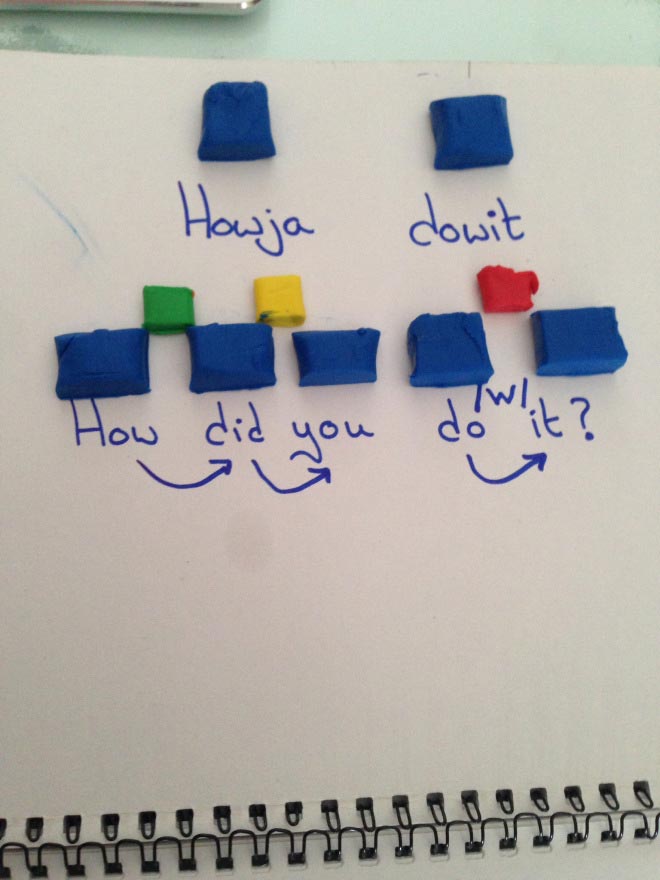
Ask your IELTS students which skill they are most worried about and listening will probably be top of the list. Most courses seem to put most emphasis on the productive skills, at the expense of reading and listening. Most textbooks don’t even teach you what connected speech is!
This post will teach you about connected speech, the inadequacies of IELTS textbooks in preparing students for the listening test and suggest some alternatives for preparing from home.
Connected Speech
Many learners are used to sympathetic teachers talking clearly and emphatically. They often focus on how the individual word sounds and this problem becomes worse the more removed their language is from English.
Once words are used in a natural rapid-fire sentence, this dependence on how individual words sound causes big problems. Some sounds disappear, some sounds are added and others seem to join together.
- Weakening of Vowels
Many vowels that were previously stressed in isolated words become weakened and are replaced by the ‘schwa’.
Example:
What are you doing? The ‘you’ changes from /ju:/ to /jə/.
- Elision
Some sounds disappear altogether when said in a sentence. For example, you might teach your students that ‘probably’ sounds like /prɒlɪ/ when it appears in a natural sentence.
It is also common for the /t/ sound to disappear from the end of words. For example, /neks/ instead of /nekst/ in the phrase ‘I’ll see you next week’.
- Assimilation
A lot of pronunciation is about efficiency and speakers often modify their pronunciation in order to save effort.
Example:
‘Ten bikes’ sounds like ‘tem bikes’. Say both. Which is easier to say?
- Catenation
When the last sound of a word is a consonant and the next sound is a vowel, they link. Think about how you would naturally say this sentence:
Is it a boy or a girl?
‘Is’, ‘it’ and ‘a’ will all link; as will ‘or’ and ‘a’.
- Intrusion
When the last sound of a word is a vowel and the next sound is also a vowel, we often add an extra sound which may be either / j /, / w / or / r /.
For example:
Law(r)and order.
IELTS Course Books
I looked at six of the most popular IELTS textbooks from four of the main publishers. Four of these books specialised in teaching students listening skills. Wouldn’t you expect them to deal with connected speech? Only one had a very small section on it and merely one exercise. Both general books dealt with it, but only within the context of speaking.
Most of the tasks in IELTS books focus on pre-listening skills. Course books seem obsessed with activating schema and asking the students to predict what they are going to hear. Although these are worthwhile things to do, if no post-listening work is done we are simply testing listening, rather than developing it.
Cuisenaire Rods
If you haven’t used these before, I would highly recommend doing so – they have a myriad of different uses in the classroom!
For connected speech, I normally ask students to put one block for each word they hear and then change it as they hear how words become connected. They can also use different coloured blocks for the different types of connected speech.

As you can see in the picture above, after the first listening the students could only hear two words and they have therefore placed two blocks above the words they hear. At this stage, it doesn’t matter if they are wrong and should just write exactly what they hear. After a few listens they have broken the sentence down into five words and placed five blocks above the words. They are then asked to think about the connected speech and place a different coloured block above each connection according to the type of sound that is added, joined or lost.
This really makes the students think about the sounds and connections and is even better if done in pairs or small groups as it leads to a lot of discussion. Most students also appreciate the visual element.
If you don’t have access to the rods you can use modelling clay, like I’ve done in the picture above. Post-it notes would work quite well.
Learning at Home
If you do this enough in class, students can start to identify and get used to connected speech when they are practising at home. I ask students to listen to as much English as possible at home, whether it be movies, podcasts, songs or just the news. When they don’t quite get what someone is saying, I advise them to pause it and listen back until they have figured out exactly what has been said. This kind of active listening is far more beneficial than passively listening to songs or TV.
For more help with improving your IELTS Listening skills, click this link to join my free IELTS Fundamentals Course.
It contains free video lessons for each section of the IELTS exam, practice exercises, answer sheets, and much more!




